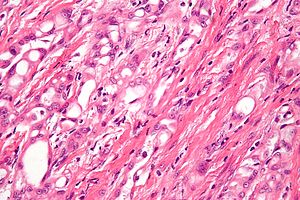Adenomatoid tumour
Jump to navigation
Jump to search
The printable version is no longer supported and may have rendering errors. Please update your browser bookmarks and please use the default browser print function instead.
Adenomatoid tumour is a rare benign tumour derived from the mesothelium.
| Adenomatoid tumour | |
|---|---|
| Diagnosis in short | |
 Adenomatoid tumour. H&E stain. | |
|
| |
| LM | small tubulocystic spaces lined by unremarkable mesothelium; the pseudotubular spaces are crossed by "thread-like bridging strands, usu. well-circumscribed |
| LM DDx | lymphangioma, leiomyoma, vascular tumours |
| IHC | calretinin +ve, CK7 +ve, AE1/AE3 +ve, WT1 +ve, CD31 -ve, desmin -ve |
| Site | uterus, adnexa (fallopian tube/ovaries), others |
|
| |
| Prevalence | uncommon |
| Prognosis | benign |
| Clin. DDx | leiomyoma, other adenxal masses |
It should not be confused with the bone tumour adamantinoma.
General
- Grossly mimics leiomyoma.[1]
- Benign tumour - derived from mesothelium.
- May be seen paratesticular.[2]
Microscopic
Features:[3]
- Well-circumscribed lesion; however, not encapsulated.
- Small tubulocystic spaces lined by cytologically normal mesothelium.
DDx:
- Lymphangioma.
- Leiomyoma, esp. lipoleiomyoma.
- Vascular tumours.
Images
IHC
Features:[6]
- Calretinin +ve.
- AE1/AE3 +ve.
- CK7 +ve.[7]
Others:[7]
- CK20 -ve.
- EMA -ve.
- HMB-45 -ve.
- Vimentin -ve.
- Desmin -ve.
- CD31 -ve.
- CD34 -ve.
- WT1 +ve.[8]
See also
References
- ↑ Huang, CC.; Chang, DY.; Chen, CK.; Chou, YY.; Huang, SC. (Sep 1995). "Adenomatoid tumor of the female genital tract.". Int J Gynaecol Obstet 50 (3): 275-80. PMID 8543111.
- ↑ González Resina, R.; Carranza Carranza, A.; Congregado Córdoba, J.; Conde Sánchez, JM.; Congregado Ruiz, CB.; Medina López, R. (Jan 2010). "[Paratesticular adenomatoid tumor: a report of nine cases].". Actas Urol Esp 34 (1): 95-100. PMID 20223139.
- ↑ Nucci, Marisa R.; Oliva, Esther (2009). Gynecologic Pathology: A Volume in Foundations in Diagnostic Pathology Series (1st ed.). Churchill Livingstone. pp. 346. ISBN 978-0443069208.
- ↑ Sangoi, AR.; McKenney, JK.; Schwartz, EJ.; Rouse, RV.; Longacre, TA. (Sep 2009). "Adenomatoid tumors of the female and male genital tracts: a clinicopathological and immunohistochemical study of 44 cases.". Mod Pathol 22 (9): 1228-35. doi:10.1038/modpathol.2009.90. PMID 19543245.
- ↑ Hes, O.; Perez-Montiel, DM.; Alvarado Cabrero, I.; Zamecnik, M.; Podhola, M.; Sulc, M.; Hora, M.; Mukensnabl, P. et al. (Oct 2003). "Thread-like bridging strands: a morphologic feature present in all adenomatoid tumors.". Ann Diagn Pathol 7 (5): 273-7. PMID 14571427.
- ↑ Canedo-Patzi, AM.; León-Bojorge, B.; de Ortíz-Hidalgo, C.. "[Adenomatoid tumor of the genital tract. Clinical, pathological and immunohistochemical study in 9 cases]". Gac Med Mex 142 (1): 59-66. PMID 16548294.
- ↑ 7.0 7.1 Terada, T. (Mar 2012). "An immunohistochemical study of adenomatoid tumors of the uterus and fallopian tube.". Appl Immunohistochem Mol Morphol 20 (2): 173-6. PMID 22553816.
- ↑ Schwartz, EJ.; Longacre, TA. (Apr 2004). "Adenomatoid tumors of the female and male genital tracts express WT1.". Int J Gynecol Pathol 23 (2): 123-8. PMID 15084840.